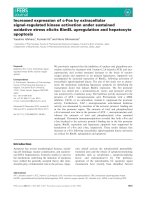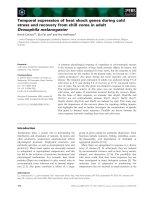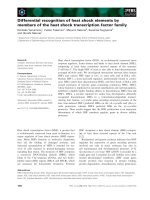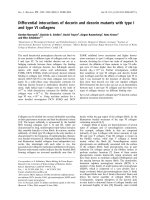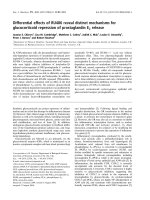báo cáo khoa học: "Differential Expression of MicroRNAs in CD34+ Cells of 5q- Syndrome" pdf
Bạn đang xem bản rút gọn của tài liệu. Xem và tải ngay bản đầy đủ của tài liệu tại đây (1.13 MB, 6 trang )
SHOR T REPOR T Open Access
Differential Expression of MicroRNAs in
CD34+ Cells of 5q- Syndrome
Hana Votavova
1*
, Martina Grmanova
1
, Michaela Dostalova Merkerova
1
, Monika Belickova
1
, Alzbeta Vasikova
1
,
Radana Neuwirtova
2
, Jaroslav Cermak
1,3
Abstract
Background: Myelodysplastic syndrome with isolated chromosome 5q deletion (5q- syndrome) is a clonal stem
cell disorder characterized by ineffective hematopoiesis. MicroRNAs (miRNAs) are important regulators of
hematopoiesis and their aberrant expression was detected in some clonal hematopoietic disorders. We thus
analyzed miRNA expressions in bone marrow CD34+ cells of 5q- syndrome patients. Further, we studied gene
expressions of miR-143, miR-145, miR-378 and miR-146a mapped within the 5q deletion.
Results: Using microarrays we identified 21 differently expressed miRNAs in 5q- patients compared to controls.
Especially, miR-34a was markedly overexpressed in 5q- patients, suggesti ng its role in an increased apoptosis of
bone marrow progenitors. Out of four miRNAs at del(5q), only miR-378 and miR-146a showed reduced gene
expression in the patients. An integrative analysis of mRNA profiles and predicted putative targets defined potential
downstream targets of the deregulated miRNAs. The list of targets included several genes that play an important
role in the regulation of hematopoiesis (e.g. KLF4, LEF1, SPI1).
Conclusions: The study demonstrates global overexpression of miRNAs is associated with 5q- phenotype.
Identification of hematopoiesis-re levant target genes indicates that the deregulated miRNAs may be involved in
the pathogenesis of 5q- syndrome by a modulation of these targets. The expression data on miRNAs at del(5q)
suggest the presence of mechanisms for compensation of a gene dosage.
Background
The 5q- syndrome is a distinct subtype of myelodysplas-
tic syndrome (MDS) with typical molecular, cytogenetic,
morphological, clinical and progno stic features; an iso-
lated interstitial deletion of the long arm of chromosome
5 [del(5q)], bone marrow blasts less than 5%, normal or
often increased platelet count, macrocytic anemia, typical
megakaryocytes and often hypoplastic erythropoiesis.
Pathophysiological basis of 5q- syndrome is likely asso-
ciated with haploinsufficiency of genes mapping to the
deleted region at 5q31-q32, so called commonly deleted
region (CDR). However, other mechanisms m ay contri-
bute to the ineffective hematopoiesis in 5q- syndrome.
MicroRNAs (miRNAs) are small non-coding RNAs that
negatively modulate expression of complementary genes
by translation inhibition or mRNA degradation. MiRNAs
have been shown to be important regulators of hemato-
poiesis and their aberrant expression was found in some
clonal hematopoietic disorders such as polycythemia vera
[1,2]. In MDS, Pons et al. analyzed gene expression of 25
hematopoiesis-relevant miRNAs in mononuclear cells
and examined possible association of their expression
with other parameters such as disease stage, r isk score
etc. [3]. Hussein et al. performed miRNA expression pro-
filing in total bone marrow (BM) cells of MDS patients
with normal karyotype and distinct cytogenetic aberra-
tions [4]. However, there is limited information on
miRNA regulation in BM progenitors of MDS. Thus, we
determined miRNA expression patterns in BM CD34+
cells of 5q- syndrome patients and searched for differen-
tially expressed miRNAs that might contribute to the
pathogenesis of 5q- syndrome. To define potential down-
stream targets of the deregulated miRNAs in 5q- patients,
we combined mRNA microarray data of the tested
patients with those of in silico miRNA target predictions.
Further, we attempted to address a gene dosage effect of
* Correspondence:
1
Department of Molecular Genetics, Institute of Hematology and Blood
Transfusion, Prague, Czech Republic
Full list of author information is available at the end of the article
Votavova et al. Journal of Hematology & Oncology 2011, 4:1
/>JOURNAL OF HEMATOLOGY
& ONCOLOGY
© 2011 Votavova et al; licensee BioMed Central Ltd. This is an Open Access article distributed under the terms of the Creative
Commons Attribution License ( , which permits unrestricted use, distribution, and
reproduction in any medium, provided the original work is properly cited.
del(5q) on gene expression of the miRNAs mapped
withinthedeletioninBMprogenitorsandperipheral
blood cells of 5q- patients.
Results and Discussion
Ineffective hematopoiesis, the hallmark of MDS, arises
from defective hematopoietic progenitors that display
retarded maturation capacity, premature apoptotic
death, and impaired growth and responsiveness to
growth factors. However, recent studies of miRNAs in
MDS were performed on partly separated or non-
separated cells of bone marrow [3,4]. In this study, we
thus focused on progenit or cells of 5q- syndro me in
order to determine miRNA expressions specific for this
cell population.
MiRNA expression pro files were assayed in bone mar-
row (BM) CD34+ cells from 5q- syndrome patients and
controls using TaqMan arrays with 365 probes. Out of
the miRNA set, transcripts of 183 miRNAs at average
were expressed at the detectable level (C
T
< 35). Com-
parative analysis determined differential expression of 21
miRNAs between 5q- patients and controls at p < 0.05
after Bonferroni corre ction; increased expression of 17
miRNAs and decreased expression of 4 miRNAs in 5q-
patients. Unsupervised hierarchical clustering performed
using this miRNA set clearly discriminated 5q- patients
from controls [Figure 1]. Higher proportion of up-
regulated miRNAs inversely correlated w ith global
down-regulation of mRNA expressions in MDS reported
previously [5]. The averaged fold changes of miRNA
expressions in 5q- patients were summarized in the
Additional file 1.
Pons et al. analyzed expression of 25 hematopoietic
miRNAs in BM mononuclear cells of MDS patient s and
identified 12 overexpressed miRNAs including miR-10a,
miR-10b and miR-126 [3]. In our study, we also detected
up-regulation of these miRNAs in 5q- progenitors. miR-
10a and miR-10b genes are embedded in the cluster o f
HOX genes that are implicated in early hematopoiesis as
well as leukemogenesis. Expression of these miRNAs
correlates with HOX gene expression, suggesting their
modulation by the same regulators as those of HOX
genes. For example, miR-126 is co-expressed with
HOXA9 mRNA in hematopoietic stem cells and down-
regulated in parallel during progenitor differentiation
[6]. Overexpression of HOXA9 was observed in BM
samples of unselected MDS pat ients [7] and it caused
stem cell expa nsion in B M mouse cells [8]. It suggests
that up-regulation of miR-126 may be associated with
the clonal cell expansion in 5q- syndrome. miR-99b and
miR-130a, up-regulated in our 5q- p atients, represent ed
other miRNAs involved in the regulation of HOX genes.
miR-34a showed the most up-regulated expression in
5q- patients compared to controls (12-fold at average,
p < 0.01). This miRNA is a direct proapoptotic tran-
scriptional target of p53 that in turn regulates the
expression of some p53 target genes. Induced expression
of miR-34a activates apoptosis by inhibition of BCL2
target gene [9]. Thus, high expression of miR-34a in 5q-
patients is likely to be related to an increased apoptosis
of BM progenitors. On the other hand, decreased
expression of miR-34a (e . g. due to p53 mutations) may
be a selective advantage in malignant cells.
In 5q- patients, we detected increased expressions of
miR-451 and miR-223 (p < 0.01 and p = 0.0503 after
Bonferroni correction) involved in the regulati on of ery-
thropoiesis that is defective in 5q- syndrome. miR-451 is
a positive regulator of erythroid cell maturation. Its
expression is very low at early stages of erythroid differ-
entiati on and rapidly increases with matu ration progress
[10]. However, the tested progenitors of 5q- patients dis-
played significant overexpression of miR-451.Target
gene(s) of hu man miR-451 are still unclear. In zebrafish,
miR-451 transcription is activated by a hematopoietic
transcription factor GATA-1 and it likely controls ery-
thropoiesis via GATA-2 target gene [11].
miR-223 is a transcriptional target of CEBPA and
plays an essential role in granulopoiesis in which targets
E2F1 [12].
In erythropo iesis, ectopic expression of miR-
223 suppresses protein levels of LMO2 and thus impairs
cell differentiation. Further, hematopoietic progenitor
cell s transduced with miR-223 show a significant reduc-
tion of their erythroid clonogenic capacity [13].
Figure 1 Unsupervised hierarchical clustering of 21
differentially expressed miRNAs between controls and 5q-
patients (p < 0.05 after Bonferroni correction). The relative
miRNA expression changes are expressed by a color gradient
intensity scale, as shown at the top. The lightest green color
indicates maximal decrease and the lightest red color indicates
maximal increase of gene expression. Each column represents a
separate CD34+ sample and each row a single miRNA. CTR- control,
P- patient.
Votavova et al. Journal of Hematology & Oncology 2011, 4:1
/>Page 2 of 6
It suggests that down-modulation of this miRNA is
required for erythroid progenitor recruitment and com-
mitment. We may speculate that the overexpression of
miR-451 and miR-223 interferes with the erythroid dif-
ferentiation in 5q- syndrome.
In total BM cells, Hussein et al. detected increased
transcript levels of m iR- 199a , miR-125a,andmiR-12 5b
in MDS patients with associated del(5q) [ 4]. We
observed the same expression pattern of these miRNAs
in 5q- BM progenitors. miR-1 25a and miR-125b are
members of a multigene family located in paralogous
clusters. The miR-125a cluster on chromosome 19
includes miR-99b and let-7e, whereas the miR-125b
cluster on chromosome 21 consists of miR-99a and
let-7c. We might conclude that these clusters were up-
regulated in 5q- progenitors since miR-125a, miR-125b,
miR-99b, miR-99a and let-7e showed increased levels
before post p-value correction. Strong up-regulation of
miR-125b is also found in MDS and AML with t(2;11)
(p21;q23) and in vitro studies show its interference with
primary human CD34+ cell differentiation [14]. In leu-
kemic cell l ines, miR-125b inhibits monocytic and gran-
ulocytic differentiation [14]. miR-125a is preferentially
expressed in long-term hematopoietic stem cells and its
activity is associated with induction of stem cell expan-
sion [15].
Expression of miR-128b showed significant decrease in
our 5q- patients. In contrast, it is overexpressed in acute
leukemias and represents one of the most discriminatory
miRNAs for ALL and AML [16]. Interestingly, miR-128b
is down-regulated in MLL-rearranged ALL and targets
MLL and AF4 genes involved in the fusion (including
their fused variants) [17]. Both these target genes play
an important role in leukemogenesis. Further, we
detected down-regulation of miR-342 expression in 5 q-
patients. This miRNA likely p lays a positive regulatory
role in the granulocytic differentiation as demonstrated
in acute promyelocytic leukemia treated by all-trans-
retinoic acid [18].
We attempted to address a gene dosage effect of del
(5q) on expression of the miRNAs mapped within this
deletion. Using a single plex qRT-PCR, we analyzed gene
expression of miR-143, miR-145, miR-378 and miR-146a
in peripheral blood (PB) granulocytes, monocytes, and T-
lymphocytes of 5q- patients and controls and in BM
CD34+ cells used for miRNA expression profiling [Figure
2]. The miRNAs showed similar gene expression patterns
in various PB cells. However, the pattern in BM progeni-
tors was considerably different, demonstrating tissue-spe-
cific regulation of these miRNAs. In PB cells, miR- 143
and miR-145 were expressed at the lower levels in patient
granulocytes (miR-143 at p < 0.01) and T-lymphocytes.
In patient monocytes, both miRNAs were expressed
at the c ontrol level. miR-378 showed non-significant
up-regulation in patient granulocytes and T-lymphocytes.
miR-146a was up-regulated in all PB patient cells and
reached statistical significance in granulocytes (p < 0.01).
In BM CD34+ patient cells, miR-143 and
miR-145
expressions
showed slight up -regulation and transcript
levels of miR-378 and miR-146a (p = 0.05) were reduced.
Similar transcript levels of these miRNAs in BM CD34+
cells of 5q- patients were found by others [19]. Moreover,
Boultwood et al. determined similar expression pattern of
these miRNAs in BM CD34+ cells of refractory anemia
patients with normal karyotype, demonstrati ng their 5q-
syndrome non-specific regulation. In contradiction with
these findings, Straczynowski et al. detected significant
down-regulation of miR-143 and miR-145 in 5q- marrow
cells and down-regulation of miR-145 and miR-146a in
CD34+ cells of three 5q- patients [20]. In mouse, they
further showed that knock-down of miR-145 an d miR-
146a caused thromboc ytosis, neutropenia and megakar-
yocytic dysplasia [20]. The result discrepancy might arise
from different numbers of tested patients and/or different
clinical parameters of patients in the cohort (e.g. number
of patients with thrombocytosis). Collectively, our results
demonstrate that gene expression of the miRNAs in the
deleted region is not significantly affected (resp. reduced)
by the loss of one allele. We assume that there are
mechanisms for compensation of the gene dosage (e.g.
epigenetic modification causing higher expression of the
retained allele) and the miRNAs cooperate to induce
5q- phenotype.
Target genes of some miRNAs at del(5q) were deter-
mined by functional studies. TRAF6 is target gene of
miR-146. miR-145 targets TIR AP that is upstream of
TRAF6 in Toll-like receptor pathway [20]. Induced
expression of TRAF6 or knock-down of miR-145 and
miR-146a in mouse BM cell s leads to the 5q- like p he-
notype [20]. In our study, miR-146a expression was
down-regulated by 30% in BM CD34+ cells of 5q-
patients. Interestingly, gene expression of this miRNA
showed increased levels in PB patient cells. Pons et al.
detected also overexpression of miR-146 in BM mono-
nuclear cells of MDS patients with del(5q) [3].
To define potential downstream targets of the deregu-
lated miRNAs in 5q- patients, we performed an integra-
tive analysis of differently expressed mRNAs and in
silico predicted targets of the miRNAs. Messenger RNA
profiles of CD34+ cells of the tested subjects have been
previously assayed using Illumina HumanRef-8 v2
Expression BeadChips w ith 22,000 gene probes. Com-
parative analysis of 5q- patients and controls detected
246 differently expressed mRNAs (p < 0.01) [5]. We
observed an inverse association betw een expressions of
these miRNAs and targets; e.g. miR-199a and CCDC34,
MRPL22; miR-34a and LEF1, KLF4, SPI1, NR4A2.All
results are summarized in the Table 1.
Votavova et al. Journal of Hematology & Oncology 2011, 4:1
/>Page 3 of 6
As shown in the target list, we noted several pot ential
target genes (e.g. KLF4, LEF1, SPI1)withanimportant
function in the regulation of hematopoiesis. KLF4 gene
is a member of the Kruppel-like family of factors (KLFs)
that play essential roles in erythrocyte and lymphocyte
development. KLF4 is expressed in a stage-specific pat-
tern during myelopoiesis an d its forced expression in
hematopoietic stem cells promotes monocyte differentia-
tion [21]. KLF4 is targeted by transcriptional factor PU.1
(SPI1) that cooperates with CEBPA to control myeloid
cell development. LEF1 is a lymphoid enhancer-binding
factor which mediates proliferation, survival and
differentiation of granulocyteprogenitors.Reduction/
deficiency of LEF1 gene leads to the defective matura-
tion of myeloid progenitors in patients with severe con-
genital neutropenia [22]. The do wn-regulation of these
targets in 5q- patients may be associated with impaired
cell differentiation. Taken together, o ur data underline
complexity of the miRNA/target regulatory network that
is being analyzed in detail by functional studies.
Our study demonstrates that the specific miRNA sig-
nature (mostly miRNA o verexpressions) is a ssociated
with 5q- phenotype. Especially, miR-34a was highly up-
regulated in 5q- syndrome patients. No tably, we found
Figure 2 Gene expression of miR-143, miR-145, miR-378 and miR-146a mapped within the del(5q) in 5q- patients. Transcript levels of
the miRNAs were detected by qRT-PCR in control (N = 12) and 5q- patient (N = 19) peripheral blood granulocytes (A), T-lymphocytes (B),
monocytes (C), and bone marrow CD34+ cells (N = 7) (D). Relative fold changes of expression were calculated by 2
-ΔΔCt
and the data are
presented as the mean plus standard error. Data were normalized to RNU48. CTR-controls, + p = 0.05, ** p < 0.01.
Table 1 Potential target genes of deregulated miRNAs in 5q- patients
miRNA ID Location Expression in 5q- Target genes with inverse expression
hsa-miR-34a 1p36.22 over LEF1, KLF4, SPI1, NR4A2
hsa-miR-223 Xq12 over EBF3, PDE4B, PLEKHM1, RHOB
hsa-miR-199a 19p13.2 over CCDC34, MRPL22
hsa-miR-335 7q32.2 over ETF1
hsa-miR-128b 3p22.3 down GPAM, RGL2
hsa-miR-520c 19q13.42 down CYBRD1
Messenger RNA profiles of CD34+ cells in the tested subjects were assayed by microarrays and putative targets of deregulated miRNAs (p ≤ 0.05) were
determined by prediction algorithm tools. The integrative analysis of differently expressed mRNAs and predicted targets identified genes with an inverse
expression pattern.
Votavova et al. Journal of Hematology & Oncology 2011, 4:1
/>Page 4 of 6
the up-regulation of several miRNAs (miR-10a/b, miR-
126, miR-99b,andmiR-130a) implicated in the regula-
tion of HOX genes. Against our expectation, not all
miRNAs at del(5q) displayed reduced gene expression.
The analysis of mRNA expressions and predicted targets
showed that aberrantly expressed miRNAs might be
involved in the pathogenesis of 5q- syndrome by the
modulation of their target genes.
Methods
Samples
Bone marrow (BM) CD34+ cells were obtained from 7
patients and 5 controls. Control CD34+ cells were pur-
chased from Lonza (Basel, Switzerland). Peripheral
blood (PB) granulocytes, T-lymphocytes and monocytes
were obtained from 19 patients and 12 controls. All
patients fulfilled WHO diagnostic criteria of 5q- syn-
drome. All subjects provided the informed consent and
the study was approved by the Local Ethics Committee.
Mononuclear cells and granulocytes were separated by
Ficoll-Hipaque density gradient centrifugation (GE Health
Care, Little Ch alfont, UK). Other cell fractions were iso-
lated by magnetic column separation using MACS kits
(Myltenyi Biotech, Bergisch Gladbach, Germany): Direct
CD34+ Progenitor Cell Isolation Kit, CD3 T-Cells Isola-
tion Kit , and CD14 Monocytes Isolation Kit. The purity
of cell populations was controlled using FACSAria (Bec-
ton Dickinson, San Jose, CA) and always exceeded 95%.
Analysis of miRNA expression
Total RNA (800 ng) was reverse transcribed into cDNA
by TaqMan MicroRNA Rever se Transcription Kit
(Applied B iosystems, Foster City, CA). TaqMan Human
MicroRNA Arrays v1.0 (Applied Biosystems) with 365
probes were analyzed on 7900HT Fast Real-Time PCR
System (Applied Biosystems). The array data were pro-
cessed using SDS v2.3 (Applied Biosys tems) and Genesis
1.6.0Beta1 software Unsuper-
vised hierarchical clustering of the data was done by
average linkage and Euclidean distance. Singleplex qRT-
PCR of miR-143, miR-145, miR-378 and miR-146a was
performed on RotorGene 3000 instrument (Qiagen, Hil-
den, Germany) using TaqMan MicroRNA Expression
Assays (Applied Biosystems). The PCR r eactions were
performed in duplicates. Relative gene expressions of
these four miRNAs correlated (r = 0.97, p < 0.01) to
those detected by multiplex qRT-PCR Array in bone
marrow samples.
All miRNA data were normalized to the endogenous
control RNU48 and relative fold changes of gene expres-
sion were calculated by ΔΔC
T
method. The statistical
sig nificance between miRNA expression of patient s and
controls was ca lculated by Student’s t-test. The p-values
were adjusted by Bonferroni corre ction for multiple
testing.
Putative target genes were predicted using algorithm
tools TargetScan 5.1 http:/ /www .targets can.org and Pic-
Tar .
Additional material
Additional file 1: Fold changes of miRNA expressions in 5q-
patients detected by TaqMan MicroRNA Arrays. The data are
presented as ratio of averaged expression in 5q- patients to averaged
expression in controls for particular miRNAs. Only fold changes with p <
0.05 after Bonferroni correction are shown.
Acknowledgements
We wish to thank Prof. Ing. Kyra Michalova, DrSc. (Center of
Oncocytogenetics, Faculty Hospital and First Faculty of Medicine, Charles
University in Prague) for cytogenetic data. We thank Mgr. Iva Sakmaryova
(Institute of Rheumatology, Prague) who kindly provided us 7900HT Fast
Real-Time PCR System. This study was supported by GA CR 301/09/P579 and
research task No.00023736 from the Ministry of Health of the Czech
Republic.
Author details
1
Department of Molecular Genetics, Institute of Hematology and Blood
Transfusion, Prague, Czech Republic.
2
1st Medical Department of Charles
University Hospital, Prague, Czech Republic.
3
Institute of Clinical and
Experimental Hematology, 1st Faculty of Medicine, Charles University,
Prague, Czech Republic.
Authors’ contributions
HV, MG, MB and AV performed the experimental work and organized data.
MDM analyzed array data. HV interpreted data and drafted the manuscript.
RN and JC critically reviewed the manuscript and provided concepts. All
authors read and approved the final manuscript.
Competing interests
The authors declare that they have no competing interests.
Received: 13 November 2010 Accepted: 6 January 2011
Published: 6 January 2011
References
1. Bruchova H, Merkerova M, Prchal JT: Aberrant expression of microRNA in
polycythemia vera. Haematologica 2008, 93:1009-1016.
2. Guglielmelli P, Tozzi L, Pancrazzi A, Bogani C, Antonioli E, Ponziani V, Poli G,
Zini R, Ferrari S, Manfredini R, Bosi A, Vannucchi AM, MPD Research
Consortium: MicroRNA expression profile in granulocytes from primary
myelofibrosis patients. Exp Hematol 2007, 35:1708-1718.
3. Pons A, Nomdedeu B, Navarro A, Gaya A, Gel B, Diaz T, Valera S, Rozman M,
Belkaid M, Montserrat E, Monzo M: Hematopoiesis-related microRNA
expression in myelodysplastic syndromes. Leuk Lymphoma 2009, 14:1-6.
4. Hussein K, Theophile K, Büsche G, Schlegelberger B, Göhring G, Kreipe H,
Bock O: Aberrant microRNA expression pattern in myelodysplastic bone
marrow cells. Leuk Res 2010, 34:1169-1174.
5. Vasikova A, Belickova M, Budinska E, Cermak J: A distinct expression of
various gene subsets in CD34+ cells from patients with early and
advanced myelodysplastic syndrome. Leuk Res 2010, 34:1566-1572.
6. Shen WF, Hu YL, Uttarwar L, Passegue E, Largman C: MicroRNA-126
regulates HOXA9 by binding to the homeobox. Mol Cell Biol 2008,
28:4609-4619.
7. Poppe B, Vandesompele J, Schoch C, Lindvall C, Mrozek K, Bloomfield CD,
Beverloo HB, Michaux L, Dastugue N, Herens C, Yigit N, De Paepe A,
Hagemeijer A, Speleman F: Expression analyses identify MLL as a
prominent target of 11q23 amplification and support an etiologic role
Votavova et al. Journal of Hematology & Oncology 2011, 4:1
/>Page 5 of 6
for MLL gain of function in myeloid malignancies. Blood 2004,
103:229-235.
8. Thorsteinsdottir U, Mamo A, Kroon E, Jerome L, Bijl J, Lawrence HJ,
Humphries K, Sauvageau G: Overexpression of the myeloid leukemia-
associated Hoxa9 gene in bone marrow cells induces stem cell
expansion. Blood 2002, 99:121-129.
9. Chang TC, Wentzel EA, Kent OA, Ramachandran K, Mullendore M, Lee KH,
Feldmann G, Yamakuchi M, Ferlito M, Lowenstein CJ, Arking DE, Beer MA,
Maitra A, Mendell JT: Transactivation of miR-34a by p53 broadly
influences gene expression and promotes apoptosis. Mol Cell 2007,
26:745-752.
10. Bruchova H, Yoon D, Agarwal AM, Mendell J, Prchal JT: Regulated
expression of miRNAs in normal and polycythemia vera erythropoiesis.
Exp Hematol 2007, 35:1657-1667.
11. Pase L, Layton JE, Kloosterman WP, Carradice D, Waterhouse PM,
Lieschke GJ: miR-451 regulates zebrafish erythroid maturation in vivo via
its target gata2. Blood 2009, 113:1794-1804.
12. Pulikkan JA, Dengler V, Peramangalam PS, Peer Zada AA, Müller-Tidow C,
Bohlander SK, Tenen DG, Behre G: Cell-cycle regulator E2F1 and
microRNA-223 comprise an autoregulatory negative feedback loop in
acute myeloid leukemia. Blood 2010, 115:1768-1778.
13. Felli N, Pedini F, Romania P, Biffoni M, Morsilli O, Castelli G, Santoro S,
Chicarella S, Sorrentino A, Peschle C, Marziali G: MicroRNA 223-dependent
expression of LMO2 regulates normal erythropoiesis. Haematologica
2009, 94:479-486.
14. Bousquet M, Quelen C, Rosati R, Mansat-De Mas V, La Starza R, Bastard C,
Lippert E, Talmant P, Lafage-Pochitaloff M, Leroux D, Gervais C, Viguié F,
Lai JL, Terre C, Beverlo B, Sambani C, Hagemeijer A, Marynen P, Delsol G,
Dastugue N, Mecucci C, Brousset P: Myeloid cell differentiation arrest by
miR-125b-1 in myelodysplastic syndrome and acute myeloid leukemia
with the t(2;11)(p21;q23) translocation. J Exp Med 2008, 205:2499-506.
15. Guo S, Lu J, Schlanger R, Zhang H, Wang JY, Fox MC, Purton LE,
Fleming HH, Cobb B, Merkenschlager M, Golub TR, Scadden DT: MicroRNA
miR-125a controls hematopoietic stem cell number. Proc Natl Acad Sci
USA 2010, 107:14229-14234.
16. Mi S, Lu J, Sun M, Li Z, Zhang H, Neilly MB, Wang Y, Qian Z, Jin J, Zhang Y,
Bohlander SK, Le Beau MM, Larson RA, Golub TR, Rowley JD, Chen J:
MicroRNA expression signatures accurately discriminate acute
lymphoblastic leukemia from acute myeloid leukemia. Proc Natl Acad Sci
USA 2007, 104:19971-19976.
17. Kotani A, Ha D, Hsieh J, Rao PK, Schotte D, den Boer ML, Armstrong SA,
Lodish HF: miR-128b is a potent glucocorticoid sensitizer in MLL-AF4
acute lymphocytic leukemia cells and exerts cooperative effects with
miR-221. Blood 2009, 114:4169-4178.
18. De Marchis ML, Ballarino M, Salvatori B, Puzzolo MC, Bozzoni I, Fatica A: A
new molecular network comprising PU.1, interferon regulatory factor
proteins and miR-342 stimulates ATRA-mediated granulocytic
differentiation of acute promyelocytic leukemia cells. Leukemia 2009,
23:856-862.
19. Boultwood J, Pellagatti A, Cattan H, Lawrie CH, Giagounidis A, Malcovati L,
Della Porta MG, Jädersten M, Killick S, Fidler C, Cazzola M, Hellström-
Lindberg E, Wainscoat JS: Gene expression profiling of CD34+ cells in
patients with the 5q- syndrome. Br J Haematol
2007, 139:578-589.
20. Starczynowski DT, Kuchenbauer F, Argiropoulos B, Sung S, Morin R,
Muranyi A, Hirst M, Hogge D, Marra M, Wells RA, Buckstein R, Lam W,
Humphries RK, Karsan A: Identification of miR-145 and miR-146a as
mediators of the 5q- syndrome phenotype. Nat Med 2010, 16:49-58.
21. Feinberg MW, Wara AK, Cao Z, Lebedeva MA, Rosenbauer F, Iwasaki H,
Hirai H, Katz JP, Haspel RL, Gray S, Akashi K, Segre J, Kaestner KH, Tenen DG,
Jain MK: The Kruppel-like factor KLF4 is a critical regulator of monocyte
differentiation. EMBO J 2007, 26:4138-4148.
22. Skokowa J, Cario G, Uenalan M, Schambach A, Germeshausen M, Battmer K,
Zeidler C, Lehmann U, Eder M, Baum C, Grosschedl R, Stanulla M, Scherr M,
Welte K: LEF-1 is crucial for neutrophil granulocytopoiesis and its
expression is severely reduced in congenital neutropenia. Nat Med 2006,
12:1191-1197.
doi:10.1186/1756-8722-4-1
Cite this article as: Votavova et al.: Differential Expression of MicroRNAs
in CD34+ Cells of 5q- Syndrome. Journal of Hematology & Oncology 2011
4:1.
Submit your next manuscript to BioMed Central
and take full advantage of:
• Convenient online submission
• Thorough peer review
• No space constraints or color figure charges
• Immediate publication on acceptance
• Inclusion in PubMed, CAS, Scopus and Google Scholar
• Research which is freely available for redistribution
Submit your manuscript at
www.biomedcentral.com/submit
Votavova et al. Journal of Hematology & Oncology 2011, 4:1
/>Page 6 of 6





